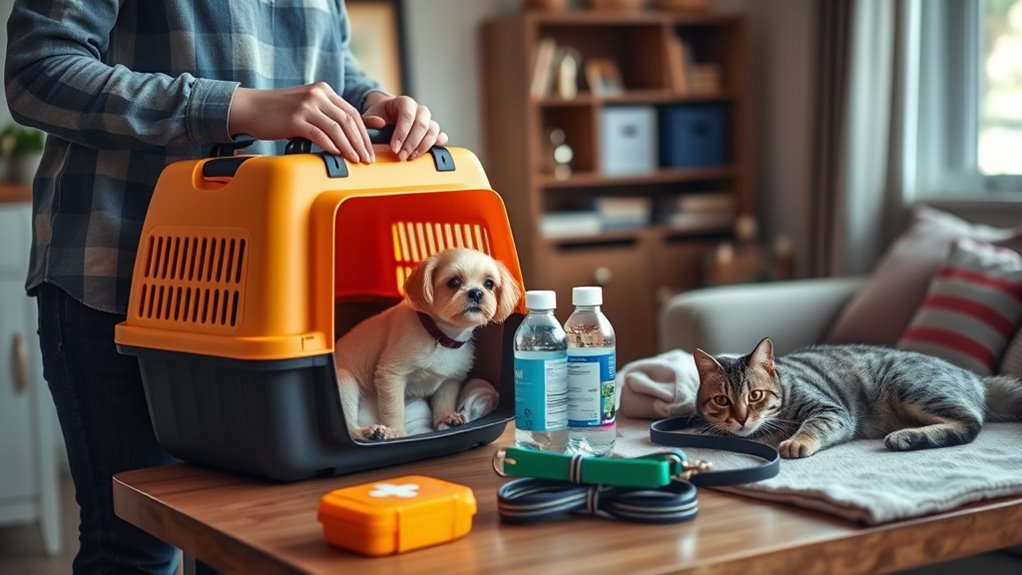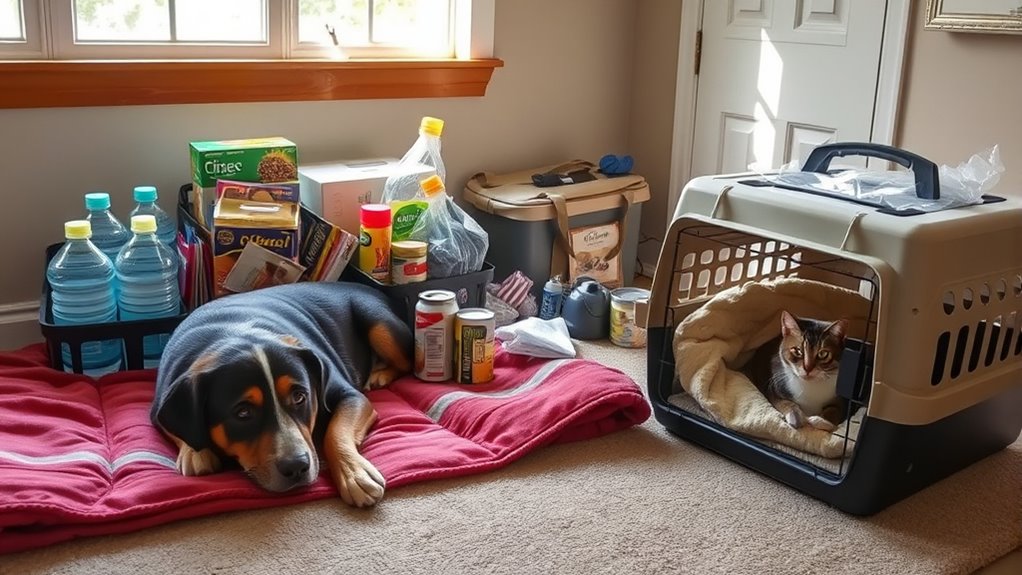To prepare your pets for natural disasters, assemble a pet emergency kit with food, water, medications, and comfort items, and include transportation tools like leashes and carriers. Develop an evacuation plan by identifying pet-friendly shelters, mapping routes, and practicing them. Keep important documents and identify your pets with microchips and tags. Stay informed about local risks and practice regular drills to make certain smooth, stress-free evacuations. Continue to explore essential tips to keep your animals safe and calm during emergencies.
Key Takeaways
- Assemble a pet emergency kit with food, water, medications, comfort items, and transportation tools.
- Develop and practice an evacuation plan, including routes, shelters, and safe accommodations.
- Keep up-to-date identification and digital copies of medical records to facilitate quick reunification.
- Stay informed about local hazards and community resources to tailor your preparedness efforts.
- Regularly train your pets for emergencies and stay calm to ensure a smooth, stress-free evacuation.

Are you ready to keep your pets safe during a natural disaster? Preparing in advance can make all the difference when chaos strikes. One of the most essential steps is assembling thorough pet emergency kits. These kits should include essentials like enough food and water to last several days, any medications your pet needs, and comfort items like their favorite toy or blanket. Don’t forget to add a leash, harness, and a carrier for easy transportation. Having these supplies ready guarantees your pet stays safe and comfortable if you need to evacuate quickly. Remember, a well-stocked pet emergency kit is your first line of defense during a crisis.
Prepare pet emergency kits with food, water, medications, and comfort items to keep your pets safe during disasters.
Equally necessary is developing a clear evacuation plan tailored to your pet’s needs. Know your local shelters and any pet-friendly accommodations in advance. Map out the quickest routes to these locations, and practice them if possible. Planning ahead helps reduce stress and confusion during an emergency. Make sure your pet is properly identified with a collar and an up-to-date ID tag that includes your contact information. Microchipping your pet is another dependable way to guarantee they can be reunited with you if they get lost. When planning your evacuation route, consider the safest and fastest options, factoring in potential road closures or hazards. Always have a backup plan in case your primary route isn’t accessible.
Incorporating your pet into your overall emergency preparedness plan guarantees that they’re not an afterthought. Keep copies of your pet’s medical records, vaccination history, and recent photos in your emergency kit and digital files. This information can be critical if you need to stay at a shelter or seek veterinary care. Proper disaster preparedness in your area can also improve your ability to stay informed and connected during a crisis, especially if you need to communicate or access updates. Additionally, understanding pet safety tips during emergencies can help you better tailor your plans to specific risks you might face. Being aware of flood zones and other environmental hazards in your community ensures your evacuation plans are comprehensive. Practice putting your pet into their carrier and going through your evacuation route periodically, so your pet becomes familiar with the process. During a disaster, staying calm and organized helps keep your pet calm as well. By preparing pet emergency kits and establishing evacuation plans, you’ll be better equipped to handle the unexpected and protect your furry friends.
Ultimately, being proactive means you won’t have to scramble when disaster strikes. Your pets depend on you to keep them safe, and with a little planning, you can guarantee they’re protected no matter what. Investing time in assembling pet emergency kits and creating clear evacuation plans will give you peace of mind, knowing you’re ready to respond swiftly and effectively. Don’t wait until it’s too late—start preparing today so you can face any natural disaster confidently, with your pets by your side.
Frequently Asked Questions
How Can I Identify Signs of Stress in My Pet During a Disaster?
During a disaster, you can identify signs of stress in your pet by observing their behavior cues and anxiety indicators. Look for behaviors like trembling, pacing, hiding, or excessive vocalization. Notice if your pet becomes unusually clingy or shows changes in eating and grooming habits. These signs help you understand their stress level, allowing you to comfort them and take steps to reduce their anxiety during chaotic situations.
What Are Essential Items to Include in a Pet Emergency Kit?
You should include essential items like pet food and emergency medications in your pet emergency kit. Pack enough pet food to last several days, along with water and bowls. Don’t forget to incorporate any necessary emergency medications your pet needs, such as prescriptions for chronic conditions. Add a leash, harness, and a familiar blanket or toy to comfort your pet. This preparation helps guarantee your pet stays safe and cared for during a disaster.
How Should I Evacuate With Multiple Pets Safely?
Evacuating with multiple pets is like orchestrating a symphony—you need coordination and calm. To overcome transportation challenges, plan ahead with secure carriers and a clear route. Make sure each pet has proper identification, like tags or microchips, to prevent separation. Keep essentials handy for all animals, and stay calm to reassure them. With preparation and patience, you can navigate the chaos and keep everyone safe.
Are There Specific Shelter Options for Pets During Disasters?
You should explore pet shelter options and emergency pet facilities in advance. Many communities offer designated shelters that welcome pets, ensuring you don’t have to leave your animals behind. Check local authorities or animal organizations for available resources. Keep important documents and supplies ready. Knowing where these facilities are located helps you evacuate quickly and safely, giving your pets a secure place during a disaster.
How Can I Keep My Pet Calm During a Crisis?
During a crisis, you can keep your pet calm by using calming techniques like gentle petting and soft voices to reduce anxiety. Create a familiar environment with their favorite blanket or toy, and stay close to reassure them. Consistent routines help manage anxiety, so stick to familiar patterns as much as possible. Remember, your calm demeanor can profoundly influence your pet’s stress levels, making anxiety management more effective during emergencies.
Conclusion
By preparing your pets now, you guarantee their safety during a disaster. Did you know that nearly 40% of pet owners haven’t planned for emergencies? Don’t wait until it’s too late—gather supplies, create a plan, and keep your furry friends close. Being proactive can make all the difference in protecting your animals and easing their stress during unexpected events. Take action today to keep your pets safe and secure when disaster strikes.










